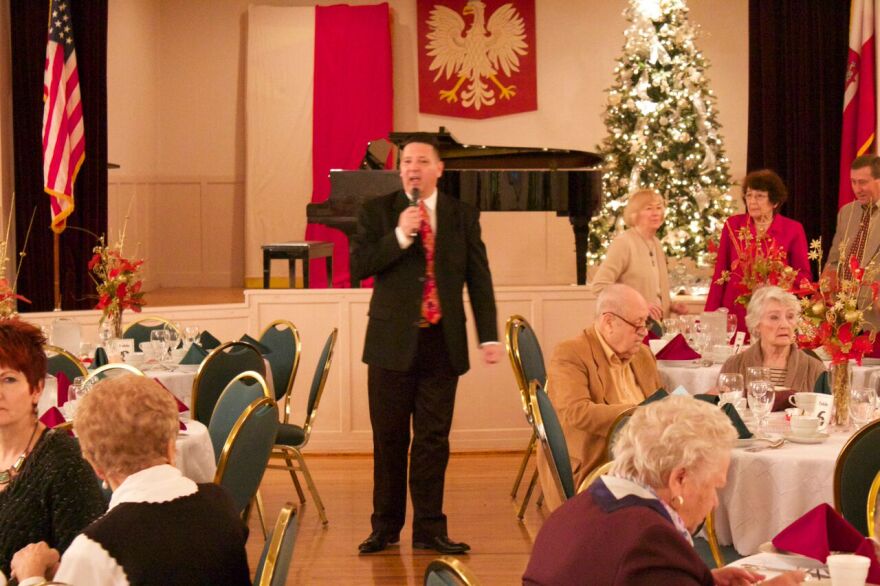It’s not Christmas Day itself. It’s the day before that’s most important to Poles and Polish-Americans.
Christmas Eve is the traditional time for faith, family and food. But in Cleveland a couple weeks before the big day, there’s a sort of rehearsal dinner.
That’s where WKSU’s Vivian Goodman takes us for today’s Quick Bite.
Three Ohio cities -- Toledo, Parma and Cleveland -- are among the top 20 in the U.S. with the largest Polish-American populations.
In Cleveland, the heart of the community is in Slavic Village at the Polish- American Cultural Center.

“I always say this is Polish home," says Case Western Reserve social work professor Richard Romaniuk, who emigrated to Cleveland in 1988.
Like home
Ten years later when this building at East 65th and Lansing Avenue opened its doors, Romaniuk was one of the first ones in. He treasures this place, and today, with cooks busy in the kitchen and friends and family gathering in the dining hall, he says it’s beginning to look a lot like a Polish Christmas.
“As far as the food is concerned is the same. In Poland, we celebrate Christmas mostly with the family. Here we celebrate in our big family, Polish family. So we are here meet with old friends, new friends."
"Wesołych Swiat," says Romaniuk, wishing Merry Christmas to his friend Gene Bak, the executive director of the Polish-American Cultural Center.
Preserving the history
The center, named for Pope John Paul II, has a museum with one room dedicated to Herbert Hoover. America’s 31st president established soup kitchens all over Poland after the devastation of World War II.
“There were about 1.3 million children fed every day,” says Bak.

The center preserves the history, promotes the culture, and keeps Clevelanders in touch with their Polish heritage.
“And today we’re celebrating Vigilia, which is the vigil before Christmas, and it’s probably the most holy day in the Polish calendar.”
Not exactly Christmas Eve but close
In the first wave of immigration to Cleveland late in the 19th century, Polish immigrants established St. John Cantius Catholic Church.
Father Andre Knapik arrives from the church on this mid-December day for the cultural center’s Vigilia.
“Brothers, sisters, despite this not exactly Christmas Eve, but we can anticipate the solemn evening today when we gather together as a Polish-American family.”
After prayers and before sitting down to dinner, friends and families share hugs and Christmas wishes.

“And we share what we call oplatek, which is a wafer, with everyone, and ask for forgiveness and friendship for the future.”
A mix of traditions
The Polish custom of breaking and sharing the Christmas wafer dates back to the 10th century.
But even earlier customs are part of the celebration.
“Poland accepted Christianity in 966,” says Gene Bak, “and from then on there are some traditions that were pagan traditions that the church kind of permitted that to continue on.”
Before dinner is served, customs are recalled.
Childhood memories

Ray Vargas, director of the Wiwaty Polish Folk Dancers, wants to share a noisy childhood memory of Vigilia.
“We would all come together. We would pound pots and pans. I said to my mother, ‘Why are we doing this?’ She says, ‘It’s to scare off all of the spirits and send them back on their merry way.’”
Christian beliefs combine with ancient folklore at Vigilia, like the custom of putting lit candles on the Christmas tree to drive away evil spirits with fire as pagans used to do.
Vargas says Vigilia dinner can’t begin until young people give the word.
“The children are usually given the assignment of looking out the window and waiting and waiting until we actually see the first star of the night.”
No meat
On this night, all animals are treated as humans, so the Vigilia supper is meatless.
“That doesn’t sound very tempting in a Polish household because we’re used to always having meat, meat, meat, “ says Vargas. “But a Polish woman does an amazing feast for Vigilia.”
On Christmas Eve, Eugenia Stolarchik will be cooking all day.
"We might start day before to prepare some

mushrooms you know overnight so they soak. But otherwise we cook in the morning to get ready for the evening."
In the kitchen
Today’sVigilia supper is ready, so cultural center Director Bak lets us visit the basement kitchen to meet the cooks.
“Soup, mushroom, famous for Christmas Eve.”
“Special mushrooms. It’s not the mushrooms like from regular store, but is the mushroom from the forest. It’s really good.”
“So we always make the pierogis, always make the fish. Bakery we got right here. Andrutti waffles, all different kinds, colorful, with the nuts, everything with nuts we baking, too. All different cookies. Polish cookies, Kolaczki they call.”
Bernadette Zubel enjoys baking for the community Vigilia.
“I used to live in the Cleveland, but I moving to Parma, even now I move to Auburn, but I still coming. We enjoy it to come here help, and our language culture keep it up.”
“So ladies and gentlemen,” says Ray Vargas, “when you come together this year at your own home Vigilia, remember our customs. Hold them dear to our heart.”
This story was originally produced on December 18, 2015.







